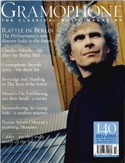Texte paru dans: / Appeared in:
*

GRAMOPHONE (10/2002)
Pour s'abonner /
Subscription information
AV9822

Code barres / Barcode: 7619986098227
Consultez toutes les évaluations recensées pour ce cd
~~~~ Reach all the evaluations located for this CD
Interview by Michael Quinn:
A QUESTION TO . . . Jordi Savall conductor
How do you approach the recording of an opera that has been out of the repertoire for so long?
Only after performing it in the opera house first, is the short answer. Originally the Teatro de la Zarzuela in Madrid invited me to get involved with a project involving Francesco Corselli's setting of Farnace, one of 15 operas based on the same libretto between 1727 and 1758. I suggested we should think about the first setting - Vivaldi's - partly because of the sheer beauty of his recitatives.
We had seven performances of Vivaldi's Farnace, complete with Corselli's later prologues to it, in Madrid before I decided to record the last two sessions. Dramatically, it is a very concentrated piece and the music reflects that, so simplicity of approach when recording was very important indeed: stereo microphones for the wider, fuller sound picture, smaller directional microphones fixed to the ceiling to pick up the recitatives, and as little editing as possible. That way you stand a better chance of catching the great spontaneity and sincerity of feeling in the writing.
Farnace is a very good combination of strong, well-contrasted da capo arias that provide strongly defined characters and that use the orchestra to carry the melody. There are three different versions: the first was to be sung only by women, the second - the version I have used - gives the title role to a tenor, and the last version, from 1738, has Tamiri, Farnace's Queen and wife, sung by a contralto.
Everyone knows that Vivaldi is a great composer of instrumental music, but we need to educate people how great an opera composer he was. So I made choices that I hope will help audiences understand this work more clearly. You can never have an ideal situation but experience helps and it's essential that you find the spirit of the piece. So, it's much easier, dramatically, to see Farnace as a man, but I have still used women - all contraltos, but all with very deliberately contrasted voices - for other 'male' roles, as Vivaldi originally intended.
Farnace is as good as any opera by Handel. It's musically and dramatically strong - which allowed a degree of improvisation in performance; it meant we were able - as we must always do - to find the unique heart and soul of the work. Once you understand the style of music, you can begin to work for it, and make it work for you.
Cliquez l'un ou l'autre
bouton pour découvrir bien d'autres critiques de CD
Click either button for many other reviews


